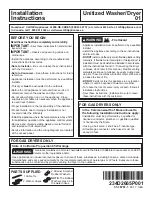
9
40
RALLONGES
ExTENSION CORDS
See Figure 1.
Use only extension cords that are intended for outdoor use. These extension cords
are identified by a marking “Acceptable for use with outdoor appliances; store
indoors while not in use.” Use only extension cords having an electrical rating not
less than the rating of the product. Do not use damaged extension cords. Examine
extension cord before using and replace if damaged. Do not abuse extension cord
and do not yank on any cord to disconnect. Keep cord away from heat and sharp
edges. Always disconnect the extension cord from the receptacle before discon-
necting the product from the extension cord. Always plug the extension cord into a
GFCI protected outlet.
To avoid the possibility of the tool plug getting wet when using an extension cord,
arrange a “drip loop” in the cord connecting the pressure washer to the extension
cord. The “drip loop” is that part of the cord below the level of the connector which
prevents water travelling along the cord and coming in contact with the connec-
tion. If the plug does get wet, DO NOT unplug the cord. Disconnect the fuse or cir-
cuit breaker that supplies power to the tool, then unplug and examine for presence
of water in the connection.
WARNING: To reduce the risk of electrocution, keep all connections dry and off the
ground. Do not touch plug with wet hands.
Voir la fig. 1.
N’utiliser que des rallonges approuvées pour usage à l’extérieur et qui sont marquées
pour un tel usage. Elles portent l’inscription : « Convient pour un usage extérieur.
Ranger à l’intérieur lorsque vous ne l’utilisez pas. ». N’utiliser que des rallonges d’un
calibre égal ou supérieur à celui du produit. Ne pas utiliser une rallonge endomma-
gée. Examiner la rallonge avant de l’utiliser et la remplacer si elle est endommagée.
Ne pas malmener la rallonge. Ne pas tirer sur la rallonge pour la débrancher. Garder
la rallonge à l’abri de la chaleur et des arêtes vives. Toujours débrancher la rallonge
de la prise avant de débrancher le produit de la rallonge. Toujours brancher la ral-
longe dans une prise électrique protégée par un disjoncteur de fuite de terre.
Pour éviter que la fiche de l’appareil devienne mouillée, quand une rallonge est
utilisée, s’assurer que le cordon d’alimentation reliant la laveuse à pression à la ral-
longe forme une « boucle d’égouttement ». La « boucle d’égouttement » est la partie
du cordon sous le niveau de la prise empêchant l’eau de couler le long du cordon
et d’entrer en contact avec la prise. Si la fiche devient mouillée, NE PAS débrancher
la rallonge. Débrancher le fusible ou fermer le disjoncteur du circuit qui alimente
l’appareil en électricité, puis débrancher le cordon et l’examiner pour vérifier la
présence d’eau dans la prise.
AVERTISSEMENT : Pour réduire le risque d’électrocution, garder toutes les prises
sèches et éloignées du sol. Ne pas toucher la fiche avec des mains mouillées.
WARNING:
When servicing, use only identical replacement parts. Use of any
other parts may create a hazard or cause product damage.
WARNING:
Always wear eye protection with side shields marked to comply
with ANSI Z87.1. Failure to do so could result in objects being thrown into your
eyes, resulting in possible serious injury.
WARNING:
Before inspecting, cleaning or servicing the machine, shut off
engine, wait for all moving parts to stop, disconnect unit from power supply, and
pull trigger to release water pressure. Failure to follow these instructions can result
in serious personal injury or property damage.
GENERAL MAINTENANCE
Avoid using solvents when cleaning plastic parts. Most plastics are susceptible to
damage from various types of commercial solvents and may be damaged by their
use. Use clean cloths to remove dirt, dust, oil, grease, etc.
WARNING:
Do not at any time let brake fluids, gasoline, petroleum-based
products, penetrating oils, etc., come in contact with plastic parts. Chemicals can
damage, weaken or destroy plastic which may result in serious personal injury.
Only the parts shown on the parts list are intended to be repaired or replaced by
the customer. All other parts should be replaced at an authorized service center.
NOZZLE MAINTENANCE
See figure 15.
Excessive pump pressure (a pulsing sensation felt while squeezing the trigger) may
be the result of a clogged or dirty nozzle.
• Unplug the pressure washer.
• Turn off the pressure washer and shut off the water supply. Pull trigger to
release water pressure.
• Remove the spray wand from the trigger handle.
NOTE:
Never point the spray wand at your face.
• Using the provided nozzle cleaning tool, free any foreign materials clogging or
restricting the nozzle.
• Using a garden hose, flush debris out of nozzle by back flushing (running the
water through the nozzle backwards or from the outside to the inside).
• Reconnect the spray wand to the trigger handle.
• Turn on the water supply.
STORING THE PRESSURE WASHER
Store in a dry, covered area where the weather can’t damage it.
It is important to store this product in a frost-free area. Always empty water from
all hoses, the pump, and the detergent container before storing.
NOTE:
Use of a pump saver will give you better performance and increase the life
of the machine.
CAUTION:
The use of a pump protector is recommended to prevent cold weather
damage during storage over the winter months.
GENERAL MAINTENANCE










































